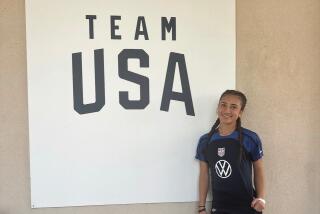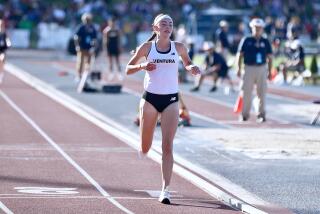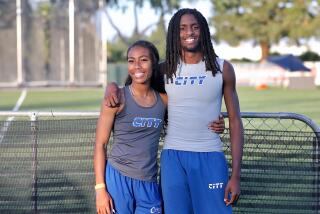THE COLLEGES / JOHN ORTEGA : CSUN Primed for Prime Time After Division II Track Finals
Although he would like to say âI told you so,â Cal State Northridge track and field Coach Don Strametz was as pleasantly surprised as anyone with the Northridge menâs second-place finish in last weekâs championships at Hampton (Va.) University.
The Matadors, who led for the first two days of the three-day meet before being overtaken by defending champion St. Augustineâs on Saturday, registered the highest finish by a Northridge team since 1979 when they also placed second.
The Matadors won the Division II title in 1975.
âOur goal going into the meet was the same as it was at the start of the season, to finish in the top 10 in both the menâs and womenâs standings,â Strametz said. âI never really thought weâd finish second. Especially with Walt (Stewart) and Tyrone (Jeffries) redshirting this season.â
Stewart, the 1989 Division II champion in the high jump, and Jeffries, a seven-time All-American in the hurdles and relays, redshirted so they could compete next year when the Matadors move to Division I.
âWe knew weâd be sacrificing points this year to make an impact next year,â Strametz said. âBut the other kids just picked up the slack in their absence.â
Freshmen Chris Perry (long jump) and Erick McBride (800 meters) and junior Kevin Hendrix (100) each won titles for Northridge, which produced three Division II champions for the first time.
Perry and McBride won the Matadorsâ first-ever titles in their respective events, and Hendrix was the first Matador to win the 100 since Steve Brodi in 1979.
âYou canât say enough about the way those three guys performed,â Strametz said. âNone of them were favored, but they all came through. For Hendrix to win the 100 with the injuries heâs had, for Perry to come from behind to win against seasoned competitors, and for McBride to win the 800 leading from the front, were just great performances.â
Although McBrideâs victory was not that shocking--he had the fastest Division II time this season--the manner in which he won was; he led from start to finish.
âWe were counting on the element of surprise, and it worked,â Strametz said. âErickâs tactics definitely caught the rest of the field off guard. . . . After the race, several of the other coaches who were along the backstretch came up to me and said, âYou did what the rest of us didnât have the guts to do.â â
Speed kills: Northridge, which totaled 60 points, had more balanced scoring than St. Augustineâs, but the Matadors could not match the Falconsâ depth in the speed department.
Based on a 10-8-6-5-4-3-2-1 scoring system, St. Augustineâs scored 100 of its 111 points in the explosive, speed-oriented events.
The Falcons racked up 18 points in the long jump, 16 in the 400-meter intermediate hurdles, and 10 each in the 100, 110 high hurdles, 400 and 1,600 relay, and high jump. They added eight points in both the 200 and triple jump.
Honor roll: Lolita Pile bounded into the Northridge record book in two categories with her performances in the Division II meet.
She became the first Northridge four-time All-American in any one track and field event when she placed second in the triple jump, and her third-place finish in the long jump and fourth-place effort as a member of the Lady Matadorsâ 400 relay made her a six-time Division II All-American, tying her with Darcy Arreola for the most by a Lady Matador.
Arreola, who is redshirting at CSUN this season, earned six Division II All-American certificates from 1987-89, and was a Division I All-American in the 1,500 meters last season, placing third.
Pile will try to match Arreolaâs feat when she competes in the triple jump in the Division I championships at Duke University this week.
Injury saga: The injury woes of Cal State Los Angelesâ Marlene Wilcox continued at Hampton.
Sidelined for several seasons with numerous physical aliments, the former Thousand Oaks High standout had a good shot to finish in the top three in the womenâs 800, but a muscle cramp in her hamstring forced her to drop out of her qualifying heat.
âSheâs had problems with (the muscle cramps) since Fresno (Relays in April),â Cal State L. A. assistant Greg Ryan said. âBut we thought we had it under control. Sheâs been seeing several specialists and they seem to think itâs a sciatic nerve problem. . . . Itâs too bad it had to happen here because she was ready to run fast. I donât think she could have beaten (Teena) Colebrook, but she was ready to run 2:06.â
Rodney on a roll: With the first three finishers breaking 46 seconds, freshman Rodney Burt of Cal State Bakersfield finished a distant fourth in the menâs 400-meter dash, yet he ran a personal best of 46.88 seconds.
Burt, from Birmingham High, had run 48.28 and placed fifth in the 400 in the City Section championships as a junior in 1988, but he faded to seventh as a senior after being slowed by injuries and the chickenpox during the season.
Burt stayed healthy this year and it showed.
After lowering his personal best to 48.02 in an early-season meet, Burt ran 47.98 at Cal Poly San Luis Obispo on April 28, won the California Collegiate Athletic Assn. title in 47.63 on May 12, and ran 47.34 to place second in his qualifying heat at nationals.
âI didnât run quite as fast as I wanted to, but Iâm pretty happy with the season,â Burt said. âWinning the CCAA meet was a big deal to me. That really helped my confidence at nationals.â
Eagle watch: Mark Walsh and Teresa Poy, two Cal State L. A. athletes with ties to the Valley area, earned All-American certificates in Hampton.
Walsh, a senior from Notre Dame High, placed sixth in the decathlon with 6,593 points.
Poy, a junior who transferred from Northridge in 1988, finished seventh in the womenâs 1,500 (4:30.65) on Saturday after a disappointing ninth (10:09.31) in the 3,000 on Friday.
Numbers watch: The California Collegiate Athletic Assn. and the Central Intercollegiate Athletic Assn. were the most powerful conferences in the Division II meet.
CCAA teams placed second, fourth and fifth in the menâs meet, and first and fifth in the womenâs, while CIAA squads finished first and third in the menâs meet, and second and sixth in the womenâs.
CCAA and CIAA athletes scored 172 points each in the menâs meet, while CCAA athletes scored 180 1/2 points and CIAA representatives totaled 136 in the womenâs meet.
More to Read
Get our high school sports newsletter
Prep Rally is devoted to the SoCal high school sports experience, bringing you scores, stories and a behind-the-scenes look at what makes prep sports so popular.
You may occasionally receive promotional content from the Los Angeles Times.






